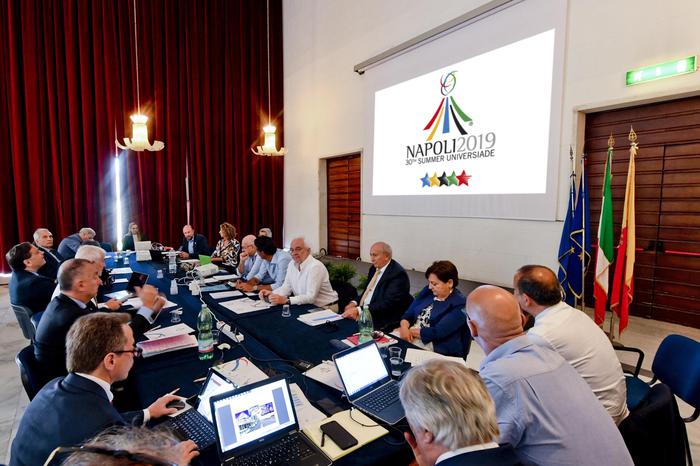There are two choices being considered for housing the athletes: either at the Mostra site, or at a combination of the Agnano Racetrack, on ships and in hotels.
In addition to Saintrond, the executives present at the meeting in Naples on Monday included: 2019 Universiade Special Commissioner Luisa Latella, CONI Services CEO Alberto Miglietta, Commissioner’s Advisor Raffaele Pagnozzi, FISU Universiade Director-General Marc Vandenplas, CUSI President Lorenzo Lentini, and staff members from FISU, ARU and CONI Services.
The meeting touched on several different topics and then proceeded to presentations of the executive plans for the athletes’ village proposals.
The plan for the Mostra was presented by Mostra President Donatella Chiodo and Mostra Managing Director Giuseppe Oliviero.
They showed a project that would locate the athletes’ village in three different cemented areas, without any impact on the surrounding architecture or landscaping.
The plan includes 2,561 housing units of one and two stories, for a total of 6,825 single beds.
Each athlete would have between seven and eight square metres of personal space, in line with FISU standards.
The presentation also included an illustration of the plumbing and sewage system as well as the electrical wiring.
The second athletes’ village proposal was presented by architect Pasquale Manduca from the Region of Campania.
He showed a plan that would provide 4,000 beds on ships docked in the Port of Naples, about 3,000 beds at the Agnano Racetrack, and 600 beds in two hotels, one in the nearby city of Pozzuoli and one in the Naples district of Fuorigrotta.
One of the questions the commission had about that plan regarded who owns the Agnano facility.
The city of Naples owns the structure, but its management is outsourced to a private company called Partenopei Racetracks, whose contract expires in March.
The project calls for building out brand-new plumbing and sewage services, as well as the electrical system and bathrooms in the housing units.
The planned surface for the project is grass, which means that a 96,000-square-metre platform would need to be built for the housing units in the area adjacent to the parking lot.
The plan includes 2,500 square metres of space for shared restrooms.
Saintrond said FISU had awarded the Universiade to Naples based on a candidacy that foresaw three “clusters” for the athletes: the former NATO base in Bagnoli, Salerno, and Caserta.
“We don’t want to modify this type of set-up, and dividing Naples in four areas is not realistic, also because we can’t be certain that between ships, Agnano and two hotels there will be the same standard for all the athletes. In addition, we recently signed a memorandum of understanding with the IOC on the Olympic Agenda 2020 to reduce organising committee costs. Two of the mainstays of the 2020 Agenda are budget control and legacy,” Saintrond said.


 Italiano
Italiano